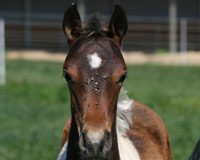In our Ask the Vet column, Dr. Lydia Gray answers your horse-health questions at horseillustrated.com/AskTheVet. Got a question for Dr. Gray? Send it to hc-editor@luminamedia.com and use subject line “Ask the Vet.”
Q: I was wondering about warts in horses. A horse I am looking after for a friend has a white wart in his ear but I also know they can get them on their face. How can warts be treated, prevented, and kept from being passed on from horse to horse?

Warts are fairly common in young horses, and often go away on their own, but certain cases may require treatment.
A. Warts in horses are often more of a cosmetic blemish best left alone, although sometimes they can be more serious of an irritation and require treatment. Both types – the ones inside the ear and the ones that appear on the face or muzzle – are caused by the contagious equine papilloma virus. Therefore, prevention is the best means of avoiding this particular problem.
The small growths on the muzzle of young horses (i.e. less than three to four years of age with yearlings being the most common age group affected) usually go away on their own in six to nine months. No treatment is generally needed unless the warts are in an area where they interfere with tack and equipment or have been irritated and developed into open sores. You may have heard of some “home treatments” to speed up the process—for example, if you’re taking your young horse to a show–but I would caution you to ask your veterinarian about the best course of action for your situation.
Adult horses who have developed immunity to warts on the muzzle are still susceptible to ear papillomas or aural plaques, which are the flat, whitish, flaky patches in the inside of the ears. Some horses don’t seem to care about them while others develop a severe ear sensitivity, making grooming, haltering, bridling, and other handling around the head very challenging. In those cases, you may want to work with your veterinarian to try some different over-the-counter or prescription ointments and see if you can make your horse more comfortable. Otherwise, since repeated handling of the ears seems to inflame the area and sensitize the horse, it may be best to simply ignore the plaques – and certainly don’t scrub or scrape them!
Preventing the spread of the equine papilloma virus will help make everyone’s life easier. Young horses that have already contracted warts should be kept separate from other horses to avoid passing along the infection. Any equipment that comes into contact with them, such as halters, bridles, brushes, feed and water buckets, hay nets, and so on should also not be shared. Because aural plaques develop when flies spread the virus, using fly masks with ears is helpful in both preventing the plaques from occurring in the first place as well as in keeping them from spreading to other horses in the herd.
Warts on the muzzle and plaques in the ears are two pretty classic and common presentations of the equine papilloma virus, but don’t hesitate to contact your veterinarian first to confirm the diagnosis and second to recommend a plan of action to treat (if necessary) and help prevent the spread of these unsightly conditions.






